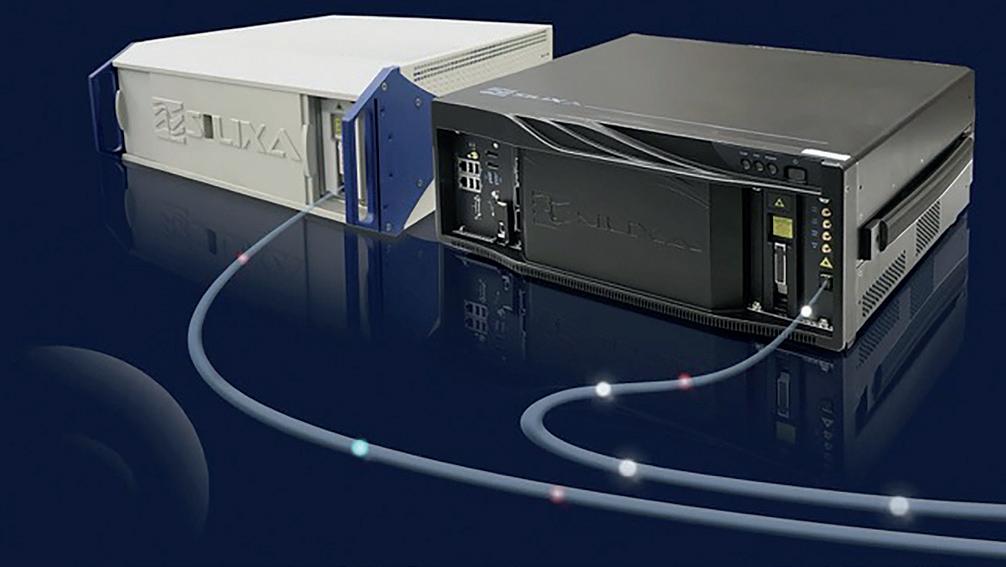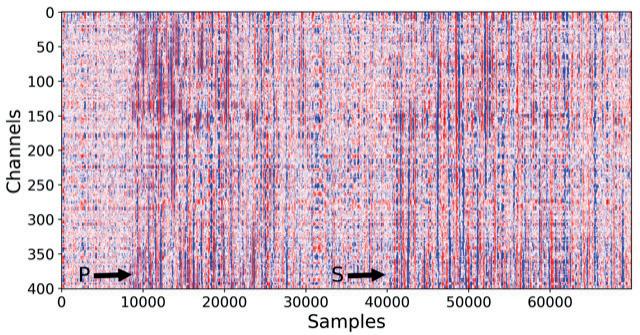
7 minute read
See the bigger picture
Michael Mondanos, PhD, Silixa, UK, describes how fibre optic sensing technology can be used to monitor geothermal operations and provide the necessary data to assist with key project decisions.
Geothermal energy can be divided into two distinct groups in the form of lowtemperature geothermal (<150˚C), typically used in direct-use applications, and high-temperature geothermal (>150˚C). The latter is suitable for power generation by circulating the fluid throughout the reservoir, transporting heat to the surface where electricity can be generated. Geothermal power plants produce electricity consistently, with highly predictable and stable power output, facilitating energy planning with remarkable accuracy.
There are three critical elements in geothermal energy: heat, fluid, and permeability at depth. An enhanced geothermal system (EGS) is an artificial reservoir created where there is hot rock but insufficient or little natural permeability or fluid saturation. In an EGS, fluid is injected into the subsurface under carefully controlled conditions that cause pre-existing fractures to re-open, creating permeability. During EGS reservoir creation and stimulation, rocks may slip along pre-existing fractures and produce microseismic or induced seismicity events. Induced seismicity data allows better subsurface characterisation but can cause public concern.
The challenges of geothermal wells
Geothermal reservoirs offer unique characterisation challenges due to the harsh environment that downhole tools are subjected to and the discrete and spatially discontinuous hydrothermal features that make up the reservoir. EGS offers great potential for dramatically expanding the use of geothermal energy by allowing the development of traditionally inaccessible thermal resources; thus, offering the possibility to reduce carbon emissions to combat anthropogenically induced

climate change significantly. However, EGS development provides an additional set of challenges as reservoir engineers have the burden of characterising the existing reservoir and dynamically guiding reservoir enhancement in heterogeneous media with an acceptable degree of resolution and accuracy. Developing EGS resources will require highly advanced and novel characterisation and monitoring methods and technologies. The efficiency of a low-temperature geothermal system depends on the thermal properties of the reservoir.
Hydrothermal and enhanced geothermal
A challenge in operating traditional hydrothermal power plants is maintaining production flow rates at high temperatures over many years of operation. Reservoir characterisation and continuous monitoring can help guide power plant operations to optimise the use of the geothermal reservoir. A challenge in developing enhanced geothermal systems is predicting the hydraulic connectivity, geomechanical properties, and permeability of fracture networks.
For EGS to serve as an effective subsurface heat exchanger, the flowing fracture network must be monitored during the evolution of the reservoir. Continuous monitoring can be utilised to target new injection and production wells, plan stimulation activities, and guide the completion of existing wells to optimise thermal recovery. Observational challenges for EGS microseismic measurements are further compounded by the intrinsic difficulty of borehole instrumentation at reservoir depths in EGS sites; the high temperatures (>150˚C) result in a hostile environment and correspondingly short lifetime for most conventional sensors.
The traditional solution to monitoring the system operation is to utilise conventional gauges and geophones. These have some limitations because of the high-temperature environment; they can hardly withstand temperatures that can reach 300˚C. In addition, they are expensive, challenging to install permanently, require power, and do not offer the spatial coverage required.
If any seismic acquisition is required, they must intervene with the well, stop production, lower the geophones into the well, and then undertake the surveys, wasting both time and money. If this activity occurs on the surface, they must lay several seismic nodes, as it is challenging to achieve the required spatial coverage.

Figure 1. Silixa’s distributed acoustic sensing (DAS) interrogators. Left: the intelligent DAS. Right: the Carina Sensing System interrogator. Light is emitted from the interrogator and the back scattered light from the fibre is recorded.

Figure 2. A recording of an M3.3 earthquake with distributed fibre optic sensing; the time of P-wave and S-wave arrivals are indicated.
A new approach to geothermal
Distributed fibre optic sensing is a rapidly advancing class of technology ideally suited to geothermal monitoring. Optical time domain reflectometry (OTDR) is one of the underlying principles enabling distributed sensing, in which an incident pulse of light is coupled into an optical fibre and the backscattered light is sampled. As the incident pulse travels along the fibre, a small amount of light is scattered and recaptured by the fibre waveguide in the return direction. Through analysis of the backscattered signal and round trip transit time from the launching end to the point of interest, dynamic profiles of the state of the optical fibre at all locations can be developed.
Geothermally relevant measurements include distributed temperature sensing (DTS), distributed strain sensing (DSS), and, most recently, distributed acoustic sensing (DAS) for microseismic, seismic, and slow strain investigations.
Silixa’s monitoring solution is based on an integrated fibre optic distributed sensing monitoring system that can be combined with hydraulic tests to better constrain the zones with permeable fractures, and an array of automated surface seismic sources to constrain each phase of fracture evolution and behaviour at the geothermal site. By using hightemperature engineered cables and interrogators capable of simultaneous DAS, DTS, and DSS measurements, the system can effectively map initial zones of mechanical stimulation using DAS microseismic monitoring; spatially-resolve elastic compliance estimates of the fractured zones using scattering, and velocity perturbations measured using time lapse VSP imaging and permanent surface seismic sources; and identify zones of flowing fractures using hydraulic tomography with low-frequency DAS strain as the detection modality.
These solutions create value for geothermal projects by offering high-quality monitoring data that can be used to optimise the geothermal system design during the exploratory and characterisation phases. Later during the production phase, it also provides a robust and cost-efficient, long-term integrated monitoring system to assist operation decisions and verify operation sustainability and safety.
Geothermal monitoring in action
A hydrothermal deployment at the Brady Hot Springs Field in Western Nevada, US, provided Silixa with the opportunity
to try and test its technology. A multi-disciplinary team led by the University of Wisconsin-Madison with partners from academia and industry developed and deployed a highly complex geothermal reservoir monitoring system including distributed fibre optic sensing as part of the US Department of Energy-funded PoroTomo project. Optical fibre cables were deployed in a shallow surface trench and an observation well. The project developed a monitoring methodology to characterise the geothermal reservoir of combined seismology, geodesy, and hydrology parameters at a depth that could be scaled to deployments for monitoring greater reservoir depths and subsequent volumes. The integrated technology developed as part of PoroTomo can be utilised at other hydrothermal and EGS sites to enhance reservoir understanding by estimating subsurface formation parameters and their uncertainties to improve operations at existing facilities and guide new development efforts. The solution consisted of deploying iDAS and ULTIMA DTS over 9 km of fibre optic cable in a trenched seismic and temperature surface array and 400 m of fibre optic cable resistant to high temperatures in a downhole array. Fibre optic sensing technology was utilised for the capability to provide dense seismic and temperature measurements with extremely fine resolution over the entire deployed fibre optic cable array. iDAS was selected for its high-performance seismic measurement capabilities including a wide dynamic sensing range and instrument stability, while ULTIMA DTS measurements allowed for fine resolution of temperature changes in the reservoir. Both technologies also have the capacity to be deployed in the harsh conditions experienced in geothermal reservoirs. iDAS was combined with an active seismic source to carry out a time lapse seismic survey. Temperature measurements from the ULTIMA DTS were combined with pressure measurements from multiple observation wells. Data was collected during four time intervals, each representative of distinct hydraulic conditions due to alterations in the flow field from manipulation in pumping and injection. Collecting time series data under varying hydraulic conditions allowed the data set to be utilised to characterise the hydraulics of the geothermal reservoir through analyses of the poroelastic response.
Both the surface and downhole fibre optic cable installations were completed successfully in late winter 2016. iDAS and ULTIMA DTS data were recorded 24 hours a day over the entire 9400 m of cable for 15 days directly following installation. Analysis of the active and passive seismic data, temperature data, and other data collected is ongoing.
Summary
Because geothermal projects have high investment and operational costs, coupled with policy uncertainty and design challenges, there is a greater need for cost-effective and innovative monitoring technologies. This is where distributed fibre optic sensing can generate value for geothermal projects by offering high-quality monitoring data that can be used to optimise the geothermal system design during the exploratory and characterisation phases. Later during the production phase, it also provides a robust and cost-efficient long-term integrated monitoring system to assist operation decisions and verify operation sustainability and safety.
The home for the latest renewables news, analysis, comment and events

Visit our website today www.energyglobal.com










